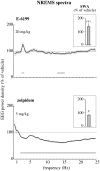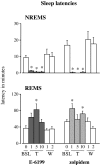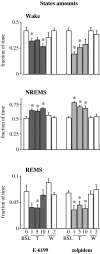Sleep-stabilizing effects of E-6199, compared to zopiclone, zolpidem and THIP in mice
- PMID: 18274274
- PMCID: PMC2225576
- DOI: 10.1093/sleep/31.2.259
Sleep-stabilizing effects of E-6199, compared to zopiclone, zolpidem and THIP in mice
Abstract
Gamma aminobutyric acid (GABA)A receptor modulators constitute the majority of clinically used sedative-hypnotics. These compounds have the capacity to initiate and maintain sleep, but decrease REM sleep and delta activity within NREM sleep. In order to avoid such sleep adverse effects, the development of novel compounds remains of interest.
Study objectives: The present study aimed at characterizing the acute effects of a novel putative hypnotic compound, E-6199, compared to zopiclone, zolpidem, and THIP on sleep-wakefulness patterns in mice. We also investigated whether repeated administration (daily injection during 10 days) of E-6199 was associated with tolerance and sleep disturbances at cessation of treatment.
Measurements and results: Polygraphic recordings were performed during 8 h after acute treatment with the various compounds. Under such conditions, E-6199 (5-20 mg/kg i.p.), zopiclone and zolpidem (2-10 mg/kg i.p.), but not THIP (2-10 mg/kg i.p.), exerted a marked sleep-promoting effect. Furthermore, E-6199 specifically increased the duration of NREM and markedly improved sleep continuity by lengthening NREM sleep episodes and reducing short awakenings and microarousal frequency. It also intensified NREM sleep by enhancing the slow wave activity within NREM at wake-NREM transitions. These effects were sustained and became even larger during chronic administration. Finally, abrupt E-6199 withdrawal did not elicit negative sleep effects.
Conclusions: Our findings demonstrate that E-6199 may be an effective hypnotic compound that promotes and improves NREMS, without producing EEG side effects, tolerance or withdrawal phenomena, when administered under chronic conditions.
Figures









References
-
- Roth T, Drake C. Evolution of insomnia: current status and future direction. Sleep Med. 2004;5(Suppl 1):S23–30. - PubMed
-
- Sateia MJ, Nowell PD. Insomnia. Lancet. 2004;364:1959–73. - PubMed
-
- Lancel M. Role of GABAA receptors in the regulation of sleep: initial sleep responses to peripherally administered modulators and agonists. Sleep. 1999;22:33–42. - PubMed
-
- Wagner J, Wagner ML. Non-benzodiazepines for the treatment of insomnia. Sleep Med Rev. 2000;4:551–81. - PubMed
-
- Gottesmann C, Gandolfo G, Arnaud C, Gauthier P. The intermediate stage and paradoxical sleep in the rat: influence of three generations of hypnotics. Eur J Neurosci. 1998;10:409–14. - PubMed
Publication types
MeSH terms
Substances
LinkOut - more resources
Full Text Sources
Other Literature Sources
Medical

